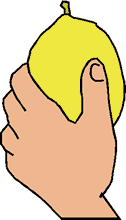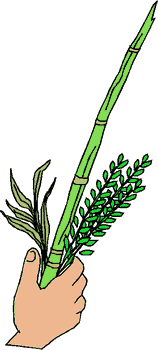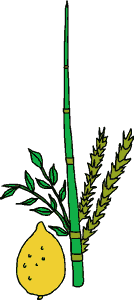|
Lulav and Etrogs and other things
By Avi Lazerson
Although the distinctive Succah booth sets the Succah Holiday apart from all other Jewish holidays, another part of the holiday is just as important. That is the Four Species, called the Lulav and Etrog. In reality the four species include the Lulav, which is a palm fond, an Etrog, which is a citron, Hadassah, which is the myrtle branches, and the Arava, which is the branches of the willow tree.
The reason behind the custom of taking these Four Species, known in Hebrew as the Arba Minim, on the Succoth Holiday is that it is a Torah commandment. It is written: (Leviticus 23:40) "And you shall take on the first day (of Succoth) a fruit of the citron tree (the Etrog), a fond of the date tree, a branch of the myrtle and a branch of the willow tree and you shall rejoice in front of your G-d for seven days."
Each one of these four species has certain rules that must be followed in order that they may be kosher.
Let us examine the first one. The etrog (citron) is very special. It is a beautifully shaped fruit that resembles an ancient tower that narrows as it rises. Imbued with a wonderful odor and a yellow or green color, the etrog is the most examined of the four species. One of the details we must pay particular attention to is that it must be of a pure specie or purebred. Today many orchards have combined various strains of trees to give tastier and stronger fruit. Sometimes the citron was mated with a lemon tree to give a taster or faster growing specie. We must be certain that the etrog is not grown from a tree that was made by combining two trees together. In many places, the etrog is sold in a box with a seal attesting to the kashrut of the etrog. It is worthy of purchasing your etrog from a reputable dealer who is known for selling only kosher etrogs.

The Etrog
In reality an etrog has an extremely thick skin and very little meat, whereas a lemon has a relatively thin skin and a large portion of edible fruit. Unfortunately, if we check it by cutting it open, we will disqualify the etrog. An etrog that is cut is not to be used for the mitzvah.
The etrog must be checked carefully to be certain that it be proper to use. The normal etrog has a little dried flower topping off its nose, a piece of a stem protruding from its underside and many bumps on its surface. The color is generally yellow, but sometimes is green. If there are no bumps on it, it is a sign that it may be a lemon or from an etrog tree that was combined with the lemon tree. The surface of the etrog should be blemish free. There are various types of spots that render the etrog unfit to use for the mitzvah. The details of spots that disqualify the etrog are many and very involved; therefore it has become the custom to show the etrog to a knowledgeable person to ascertain that, in deed, this is a kosher etrog.
The next specie is the Lulav. This is the long thin fond from the date tree. Again there are certain types of palm trees that produce the kosher variety of lulavs and other palm trees that produce lulavs that are not kosher to use. Therefore, similar to the etrog, a knowledgeable person should check the Lulav.
The Lulav should be minimum of sixteen inches long, but in an emergency one of about thirteen and half inches can be used. There is no limit to the length, but one that is straight and not bent, fresh and green, should be selected. If there is no green in the Lulav, then it is considered dry and unacceptable.

The Lulav with the Arav on the left and Haddassim on the right
The Hadas or myrtle that is used is one that has the leaves arranged in tiers of three leaves shooting out of the branch at the same level on the branch. The leaves turn up covering the wood of the branch, and each tier of three leaves begins where the one below ends. The top must be checked that it is not cut and it is preferable to select one in which the new three-leafed tier is perfect. The length of the hadasim is about twelve inches.
The fourth specie used is the aravah, the willow branch. This is the most fragile of the four species. It is called the "aravai nahal" (meaning that it grows by the river) since without water it wilts extremely fast. The leaves of the willow are long and smooth and the stems of the tree have a bit of a reddish hue. Here also the accepted length is about twelve inches. The end of the branch must not be clipped and it is best to find one that has the new leave about to sprout; this is called "melulavim".

Three Haddassim
We generally take three hadas twigs and two aravah branches and bind them together with the Lulav. Most people put the hadas on the right side of the backbone of the Lulav and the aravah on the left. Some people have the custom to add more hadasim to this minimum number, but no one adds more aravot. Some people keep the aravot and the hadasim separate and others mix them together. Either manner is acceptable.
The etrog is held in the left hand and the Lulav which is bound with the hadasim and the aravot is held in the right hand. Some have the custom to making the blessing on them in the Succah before going to the synagogue in order to unite the four species together with the mitzvah of the Succah. Others prefer to wait until they reach the synagogue and make the blessing just before the "Hallel" prayer (praising G-d).
The four species are not handled on the Shabbat. The first day of the Holiday is the most important in regard to the regulations of the four species. From the second day onwards, the rules are relaxed in certain areas and inferior species can be used - but again, a competent person should be consulted to ascertain the kashrut of the species.
Generally, the four species are taken thusly: the etrog in the left hand and the other three, which are bound together, in the right. The etrog is held upside down, meaning the stem up, during the blessing and then turned up the correct way, with the stem down. The lulav with the hadasim and aravot are held pointing upward. After the blessing they are shaken in a manner in which they "draw" from the six sides of our existence: in front of us, behind us, to the right and to the left, up and down. We extend out the four species in each of these six directions three times. Three times in one direction, and then three times in the next. We extend our and then draw them back to our heart.
Like the matzoth on Passover, the kashrut of the four species is a very intricate and complicated matter. In all cases, a person who wishes to be G-d fearing and desires to do this mitzvah correctly must consult a competent person. The original mitzvah of the four species was a procession in the Holy Temple in Jerusalem. Now since our Temple has been destroyed, we continue the tradition in the synagogue. May it be the desire of our Holy G-d that he rebuild His Holy of Holies, the Temple in Jerusalem and that we shall merit once again, like our ancestors, to take the four species in the procession in the Temple.

The Etrog, with the Lulav and the Arav on the left of the Lulav and Haddassim on the right
~~~~~~~
from the September-October 2004 Edition of the Jewish Magazine
|











